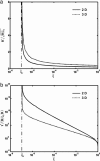Mechanics of receptor-mediated endocytosis
- PMID: 15972807
- PMCID: PMC1172266
- DOI: 10.1073/pnas.0503879102
Mechanics of receptor-mediated endocytosis
Abstract
Most viruses and bioparticles endocytosed by cells have characteristic sizes in the range of tens to hundreds of nanometers. The process of viruses entering and leaving animal cells is mediated by the binding interaction between ligand molecules on the viral capid and their receptor molecules on the cell membrane. How does the size of a bioparticle affect receptor-mediated endocytosis? Here, we study how a cell membrane containing diffusive mobile receptors wraps around a ligand-coated cylindrical or spherical particle. It is shown that particles in the size range of tens to hundreds of nanometers can enter or exit cells via wrapping even in the absence of clathrin or caveolin coats, and an optimal particles size exists for the smallest wrapping time. This model can also be extended to include the effect of clathrin coat. The results seem to show broad agreement with experimental observations.
Figures





Comment in
-
Shedding light on the dynamics of endocytosis and viral budding.Proc Natl Acad Sci U S A. 2005 Jul 19;102(29):9997-8. doi: 10.1073/pnas.0504555102. Epub 2005 Jul 11. Proc Natl Acad Sci U S A. 2005. PMID: 16009932 Free PMC article. No abstract available.
References
-
- Cann, A. J. (1997) Principles of Molecular Virology (Academic, San Diego).
-
- Levy, J. A., Fraenkel-Conrat, H. F. & Owens, R. A. (1994) Virology (Prentice–Hall, New York).
-
- Alberts, B., Bray, D., Lewis, J., Raff, M., Roberts, K. & Watson, J. D. (1994) Molecular Biology of the Cell (Garland, New York).
-
- Russell, D. G. & Marsh, M. (2001) in Endocytosis, ed. Marsh, M. (Oxford Univ. Press, Oxford), pp. 247-280.
Publication types
MeSH terms
Substances
LinkOut - more resources
Full Text Sources
Other Literature Sources

